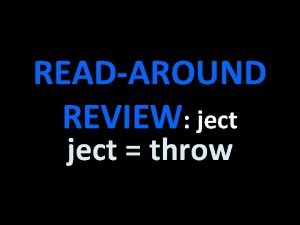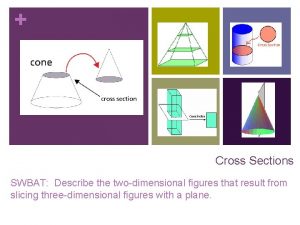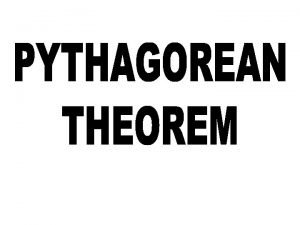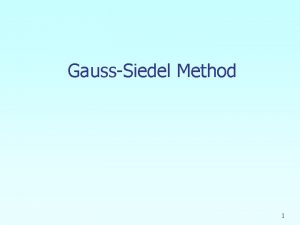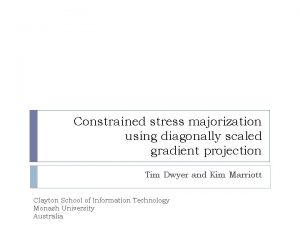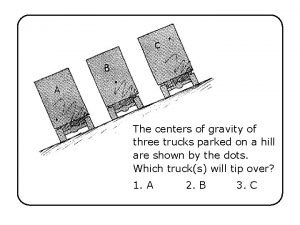I feel like Im diagonally parked in a










![D) Application: Derivatives Ji = - DS ( [Ci ]/ z) DS = D D) Application: Derivatives Ji = - DS ( [Ci ]/ z) DS = D](https://slidetodoc.com/presentation_image_h2/131bb045d1242daf0030df6947be3d97/image-11.jpg)
![D) Application: Derivatives Ji = - DS ( [Ci ]/ z) DS = D D) Application: Derivatives Ji = - DS ( [Ci ]/ z) DS = D](https://slidetodoc.com/presentation_image_h2/131bb045d1242daf0030df6947be3d97/image-12.jpg)



![D) Application: Integral (x) = Polynomial (6 th degree) ∫ (xn) = [n(n+1)/(n+1)] + D) Application: Integral (x) = Polynomial (6 th degree) ∫ (xn) = [n(n+1)/(n+1)] +](https://slidetodoc.com/presentation_image_h2/131bb045d1242daf0030df6947be3d97/image-16.jpg)
- Slides: 16

“I feel like I’m diagonally parked in a parallel universe”

Math Review Monday June 7 2003 A) Introduction a. Symbols b. Operations c. Central Tendencies B) Linear Algebra C) Correlation/Regression Analysis D) Applied Calculus

Basic Math Review B) System of equations a) 3 x - y = -7 5 y + 5 = -5 x b) 3 x + 4 y = 2 2 y = 4 - 3/2 x

Basic Math Review D) Applied Calculus Rate of change (slope): Dy/Dx or (y 2 -y 1)/(x 2 -x 1) Here Dy/Dx is constant regardless of the “limit”

Basic Math Review D) Applied Calculus How long does it take to fill one beaker (1 L)? V(t) t

Basic Math Review D) Differential equations A differential equation is an equation in which one or more unknowns depend on its/their rate of change (or that of other variables included in the equations) Newton’s principia

Basic Math Review D) Definition of a derivative The derivative of a function (x) at a point “a” is the slope of the straight line tangent to (x) at “a” instantaneous rate of change! One is pushing to limit to “ 0”: the slope is close to real as (x) approaches 0

Basic Math Review D) Definition of a derivative The derivative of a function (x) = f’(x) Important derivatives: f(x) = C f’(x) = 0 f(x) = xn f’(x) = nxn-1 f(x) = ex f’(x) = ex f(x) = lnx f’(x) = 1/x

Basic Math Review D) Maxima, Minima One of the great applications of calculus (particularly in economics) is to determine the “maxima” and “minima” of functions. The derivatives of the maxima and minima = 0 The function neither increase nor decreases! f(x) = x 3 – 3 x 2 – 24 x + 5 f’(x) = 3 x 2 – 6 x – 24 3 (x 2 – 2 x – 8) 3 (x + 2)(x – 4) f’(x) vanishes (reaches a critical point) only when f’(x) = 0

D) Maxima, Minima f”(x) < 0 maximum f”(x) > 0 minimum
![D Application Derivatives Ji DS Ci z DS D D) Application: Derivatives Ji = - DS ( [Ci ]/ z) DS = D](https://slidetodoc.com/presentation_image_h2/131bb045d1242daf0030df6947be3d97/image-11.jpg)
D) Application: Derivatives Ji = - DS ( [Ci ]/ z) DS = D 0 2 J Cz=0 = - 3 D 0 (8 o. C) ( [Ci ]/ z)z=0
![D Application Derivatives Ji DS Ci z DS D D) Application: Derivatives Ji = - DS ( [Ci ]/ z) DS = D](https://slidetodoc.com/presentation_image_h2/131bb045d1242daf0030df6947be3d97/image-12.jpg)
D) Application: Derivatives Ji = - DS ( [Ci ]/ z) DS = D 0 2 J Cz=0 = - 3 D 0 (8 o. C) ( [Ci ]/ z)z=0

“A River (used to) Run Through It”: Part I

Reservoirs and soil erosion

D) Application: Integral
![D Application Integral x Polynomial 6 th degree xn nn1n1 D) Application: Integral (x) = Polynomial (6 th degree) ∫ (xn) = [n(n+1)/(n+1)] +](https://slidetodoc.com/presentation_image_h2/131bb045d1242daf0030df6947be3d97/image-16.jpg)
D) Application: Integral (x) = Polynomial (6 th degree) ∫ (xn) = [n(n+1)/(n+1)] + C Integral between two limits (0 and 85 yrs) ∫ (xn)100 - ∫ (xn)0 C-C
 Parked diagonally in a parallel universe meaning
Parked diagonally in a parallel universe meaning To feel sad to feel thrown down in spirit
To feel sad to feel thrown down in spirit Pentagonal prism vertical cross section
Pentagonal prism vertical cross section Oscars dog house is shaped like a tent
Oscars dog house is shaped like a tent Gauss seidel formula
Gauss seidel formula Gauss seidel formula
Gauss seidel formula Can you move diagonally in clue
Can you move diagonally in clue Match each vocabulary word to the correct meaning.
Match each vocabulary word to the correct meaning. Drivers ed chapter 6
Drivers ed chapter 6 Steering straight backward
Steering straight backward Which sentence contains a participle?
Which sentence contains a participle? Bu works central
Bu works central What does burnout feel like
What does burnout feel like In the time of the butterflies chapter 10 quotes
In the time of the butterflies chapter 10 quotes How do you know if your period is coming or your pregnant
How do you know if your period is coming or your pregnant I feel like a limp dishrag
I feel like a limp dishrag What does shark skin feel like
What does shark skin feel like

